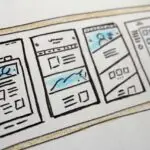Website redesign: when and why should you do it?
- Le
A website is the digital storefront of your business. However, over time, it can become outdated, less efficient, and misaligned with your objectives. So, when is the right time for a website redesign, and what benefits can it bring? Let’s dive in.
When Should You Consider a Website Redesign?
A website should never be static—it must evolve to stay relevant, meet user expectations, and adapt to new design trends. But how do you know when it’s time for a redesign? Here are some key indicators:
> Your Design Is Outdated
Your website’s appearance no longer aligns with modern design trends, making it look outdated. If your visual identity doesn’t reflect your brand properly, you risk losing credibility and visitors.
> Poor User Experience (UX)
If your navigation is complex, menus are unclear, and content organization is confusing, visitors will struggle to find what they need. The result? They leave your site quickly, which increases your bounce rate and lowers conversion rates.
> Slow Loading Speed
Internet users are impatient—40% of visitors abandon a page if it takes longer than three seconds to load. A slow website not only frustrates users but also harms your SEO rankings, as Google prioritizes fast-loading sites.
> Not Mobile-Friendly
With over 60% of global web traffic coming from smartphones, a website that doesn’t display correctly on mobile devices can significantly reduce your audience and conversions.
> Declining Search Engine Rankings (SEO Issues)
If your website is no longer ranking on the first page of Google, it might be time for an SEO audit. A poorly structured, slow, or outdated site can cause a decline in visibility.
>Lack of Key Features
If your business has evolved but your website hasn’t, you might be missing essential features like an e-commerce store, membership area, or blog. If your site’s current framework doesn’t support these additions, you may be patching solutions together instead of having a cohesive system.
If your site exhibits multiple of these issues, it’s likely due for a redesign to stay competitive, improve user experience, and boost conversions.
Why redesign a website?
A website redesign is more than just a visual upgrade. It’s a strategic move to enhance your brand image, attract more visitors, and increase conversion rates.
> Strengthen Brand Image: A modern, visually cohesive design aligned with your brand identity builds trust and presents a more professional image to visitors.
> Optimize User Experience (UX): Smooth navigation, well-structured pages, and a clean design encourage users to stay longer on your site and reduce bounce rates.
> Boost Performance: A faster website enhances user experience and improves your ranking on Google.
> Improve SEO: Redesigning your site gives you the opportunity to optimize meta tags, content, and site structure for better visibility in search engine results.
> Adapt to New Technologies: Implementing the latest web design trends, animations, and functionalities keeps your site modern and competitive.
Ultimately, a website redesign is a strategic approach to modernizing your online presence, improving user experience, and optimizing visibility on search engines. By aligning your site with the latest trends and technologies, you strengthen your brand identity and maximize visitor-to-customer conversion rates.
Full or Partial Website Redesign: Which One to Choose?
When talking about website redesign, it is important to distinguish between two approaches: partial redesign and full redesign. The choice will depend on the current state of your site, your goals, and the issues you need to address.
A partial redesign focuses on improving specific aspects of the website, such as design, content, or SEO, without modifying the entire architecture. This is a good solution if your site is functional but needs a visual or technical update.
A full redesign involves a complete overhaul of the design, structure, content, and user experience (UX). It is often necessary when a site is too old or poorly built from the start.
In summary, if your site only needs minor improvements, a partial redesign may be sufficient. However, if its structure is outdated, difficult to manage, or no longer meets current web standards, a full redesign is essential to ensure performance, efficiency, and long-term success.
Conclusion: A Website Redesign, a Strategic Lever for Your Business
Redesigning your website is more than just a visual upgrade. It’s an opportunity to enhance user experience, optimize performance, and boost your online visibility. A modern, fast, and well-optimized site is a powerful tool to turn visitors into customers.
If your website is slow, poorly structured, or no longer aligns with your brand, now might be the perfect time to take action and give it a fresh new look!
Got a project in mind?
Let’s discuss it together!
Do you have a website idea, a redesign, or a digital project in progress? Let’s talk!
From analyzing your needs to bringing your project to life, I provide a tailored approach. With my expertise in creating and redesigning custom websites, I develop solutions that fit your specific requirements.
- Personalized support at every step.
- Expert advice to optimize your project.
- A fast, modern, and well-referenced website.
- Full transparency on the process and timelines.
Fill out the form and receive a response within 24 to 48 hours.




